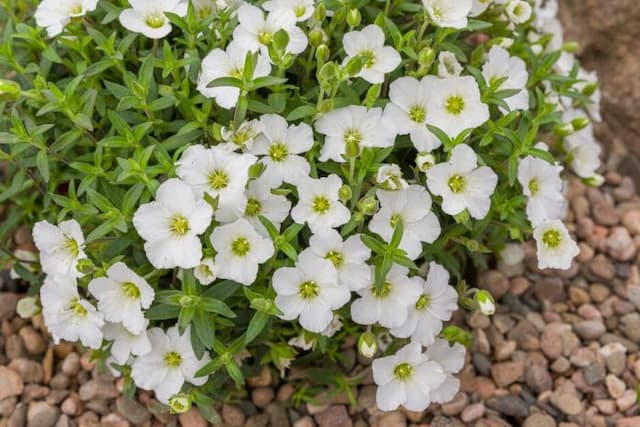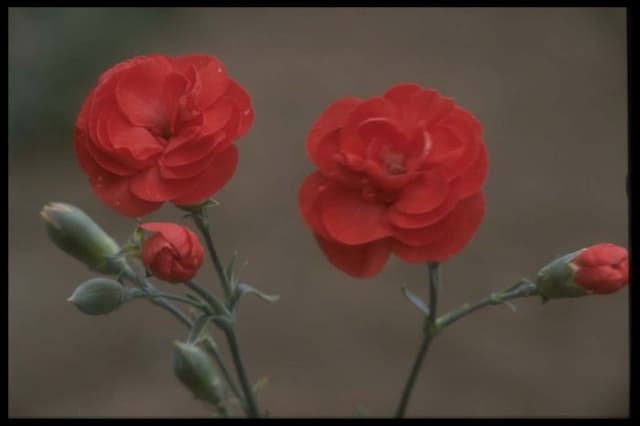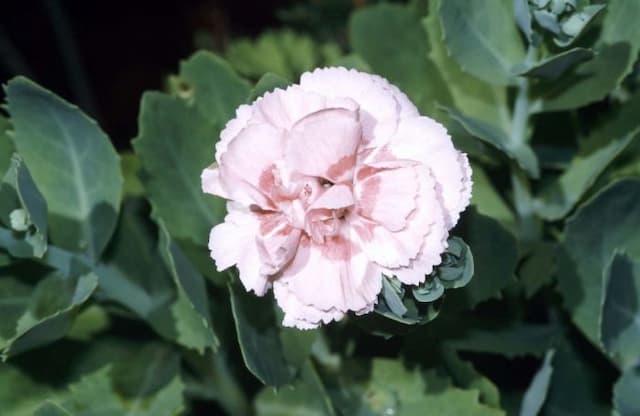Sweet William Dianthus 'Kathleen Hitchcock' (b)

ABOUT
Dianthus 'Kathleen Hitchcock' is known for its striking and vivacious appearance. This plant boasts a lush green mound of narrow, linear leaves that create an attractive backdrop for the flowers. The blooms are the real showstoppers, featuring vibrant double flowers that exude a spicy, clove-like fragrance. Each flower is comprised of frilled petals that are typically a soft pink or salmon color, often with a deeper or contrasting eye in the center, giving the blossoms a two-toned effect. These showy flowers are held aloft on slender stems, creating a floating appearance that adds a touch of elegance to the garden. The Dianthus 'Kathleen Hitchcock' plant is a popular choice for adding a splash of color and a delightful scent to rock gardens, borders, and containers.
About this plant
 Names
NamesFamily
Caryophyllaceae
Synonyms
Sweet William, Pink, Carnation
Common names
Dianthus 'Kathleen Hitchcock'.
 Toxicity
ToxicityTo humans
Carnation is generally considered non-toxic to humans. However, if any part of the plant is ingested in large quantities, it may cause stomach upset or mild gastrointestinal symptoms due to the presence of saponins. No severe toxicity is typically associated with the carnation.
To pets
Carnation is typically non-toxic to pets as well. While it isn't considered a commonly poisonous plant, if a pet were to ingest a large amount, it could potentially experience mild gastrointestinal distress, such as vomiting or diarrhea, due to the presence of saponins in the plant. However, such cases are not common and carnations are generally safe for pets.
 Characteristics
CharacteristicsLife cycle
Perennials
Foliage type
Evergreen
Color of leaves
Blue-green
Flower color
Pink
Height
1 foot (0.3 meters)
Spread
1 foot (0.3 meters)
Plant type
Herb
Hardiness zones
7
Native area
Europe
Benefits
 General Benefits
General Benefits- Attracts pollinators: Dianthus 'Kathleen Hitchcock' attracts bees and butterflies, promoting pollination in your garden.
- Low maintenance: Once established, it requires minimal care, making it ideal for busy gardeners or those looking for low-effort landscaping.
- Drought tolerance: It can withstand periods of dry weather, reducing the need for frequent watering.
- Long blooming period: Offers a long season of color in the landscape with its beautiful pink flowers.
- Fragrant flowers: The blooms emit a pleasant scent that can add an aromatic dimension to your garden space.
- Compact size: Its small stature makes it suitable for borders, containers, and small garden spaces.
- Evergreen foliage: Provides year-round visual interest with its evergreen leaves, adding to the aesthetic appeal of your garden.
 Medical Properties
Medical PropertiesThis plant is not used for medical purposes.
 Air-purifying Qualities
Air-purifying QualitiesThis plant is not specifically known for air purifying qualities.
 Other Uses
Other Uses- Culinary Garnish: The petals of the Dianthus 'Kathleen Hitchcock' can be used to add a splash of color and subtle flavor to salads and desserts.
- Botanical Dye: The vibrant blooms can be used to create natural dyes for fabrics or paper crafting.
- Companion Planting: These plants can be placed in the vegetable garden to attract pollinators, which will improve the yield of vegetables and fruits.
- Crafting Potpourri: The dried petals retain their scent and color, making them perfect for homemade potpourri mixes.
- Floral Arrangements: Fresh or dried, the flowers can be used in bouquets or floral arrangements to provide long-lasting color and form.
- Decorative Confetti: Dried petals can be used as a natural and biodegradable confetti for weddings or celebrations.
- Art Supplies: The petals can be used in pressed flower art or to adorn homemade paper, adding texture and color.
- Seed Harvesting: Seeds from spent blooms can be collected and used for planting more Dianthus, or for trading with fellow gardeners.
- Insect Repellent: Some gardeners use Dianthus flowers around the garden as a natural way to deter unwanted insects without chemicals.
- Fragrance Making: The scent of Dianthus 'Kathleen Hitchcock' can be infused into oils or candles to bring its fragrance indoors.
Interesting Facts
 Feng Shui
Feng ShuiThe Dianthus is not used in Feng Shui practice.
 Zodiac Sign Compitability
Zodiac Sign CompitabilityThe Dianthus is not used in astrology practice.
 Plant Symbolism
Plant Symbolism- Love: Dianthus is traditionally associated with love and affection. Its name comes from the Greek words "dios," meaning divine, and "anthos," meaning flower, suggesting a heavenly embodiment of love.
- Admiration: The bold and colorful appearance of Dianthus flowers, including Dianthus 'Kathleen Hitchcock', can symbolize admiration and high esteem held for a person.
- Passion: The bright and vibrant hues of the Dianthus 'Kathleen Hitchcock' are often linked with feelings of passion and strong emotion.
- Boldness: With its striking colors and patterns, this plant can represent boldness and the willingness to stand out from the crowd.
- Pure Affection: In addition to passionate love, Dianthus can also symbolize a pure and platonic form of affection between friends and family.
 Water
WaterSweet William should be watered deeply to thoroughly moisten the soil, and then allowed to dry out slightly between waterings to prevent root rot. This typically translates to watering once a week with approximately one to one and a half gallons of water, depending on the climate and soil drainage. During hot, dry spells, you may need to water twice a week, whereas in cooler, cloudy weather, less frequent watering may be required. Overhead watering should be avoided to prevent disease; instead, water at the base of the plant early in the day. Adjust watering frequency based on rainfall and check the soil moisture by feeling it a couple of inches below the surface.
 Light
LightSweet William thrives best in full sun to partial shade conditions. The ideal spot for this plant is one where it can receive at least six hours of direct sunlight each day. While partial shade is acceptable, especially in hotter climates, too much shade can lead to poor blooming and leggy growth. Therefore, a sunny spot in the garden is the best choice for vibrant growth and flowering.
 Temperature
TemperatureSweet William prefers temperate conditions and performs best when nighttime temperatures are between 50-60 degrees Fahrenheit and daytime temperatures range from 70-75 degrees Fahrenheit. The plant can survive minimum temperatures as low as 40 degrees Fahrenheit and maximum temperatures around 80 degrees Fahrenheit, but prolonged exposure outside this range can be detrimental. For optimal growth and flowering, it is important to maintain the ideal temperature conditions as much as possible.
 Pruning
PruningSweet William should be pruned to remove spent flowers, which encourages further blooming and prevents the plant from spending energy on seed production. Deadheading can be done throughout the blooming season as necessary. Additionally, cutting back the foliage after flowering can also promote denser growth and may lead to a second flush of blooms. Prune in late fall or early spring to maintain a compact, healthy shape and improve air circulation.
 Cleaning
CleaningAs needed
 Soil
SoilDianthus, commonly known as "Pinks," prefers well-draining, loamy or sandy soil with a pH range of slightly alkaline to neutral, about 7.0 to 8.0. A good soil mix for pinks would be equal parts of garden soil, sand or perlite, and compost or well-rotted manure to provide nutrients.
 Repotting
RepottingCarnations or Pinks should be repotted every 1-2 years to replenish the soil and provide room for root growth. The best time to repot is in the spring or early fall to minimize stress on the plant.
 Humidity & Misting
Humidity & MistingPinks require relatively low humidity conditions and are suited to the typical humidity found in temperate climates. High humidity can promote fungal diseases, so adequate air circulation is important.
 Suitable locations
Suitable locationsIndoor
Place in bright indirect light, well-draining soil, cool temps.
Outdoor
Full sun, well-draining soil, space 12 inches apart.
Hardiness zone
3-9 USDA
 Life cycle
Life cycleThe life of the Dianthus 'Kathleen Hitchcock', commonly known as Border Pink, begins with the germination of seeds planted in well-draining soil and under the right temperature conditions. Upon germination, the seedlings emerge and grow into vegetative plants, developing a rosette of blue-green foliage. As the plants mature, they enter the flowering stage, producing vibrant pink flowers with frilled edges and a sweet fragrance, typically in late spring to early summer. After pollination, which is often facilitated by insects, the flowers produce seed capsules containing seeds that can be dispersed by wind or other means. Post-flowering, if not deadheaded, the plant may enter a period of dormancy, particularly in hotter climates, before resuming growth in the next favorable season. The Border Pink may also be propagated through cuttings or division, which allows gardeners to bypass seed germination, leading to quicker establishment of mature plants.
 Propogation
PropogationPropogation time
Spring-Early Summer
The Dianthus 'Kathleen Hitchcock', commonly known as Pink, is typically propagated by cuttings. The most popular method involves taking non-flowering shoots from the plant during the active growing season in late spring or early summer. You should select healthy and vigorous stems about 4 to 6 inches (10 to 15 centimeters) long and cut just below a node. Remove the lower leaves and dip the cut end in a rooting hormone to encourage root growth. Then, plant the cutting in a well-draining soil mixture, keeping it moist and in a warm, bright spot out of direct sunlight until roots have developed and new growth is visible, which usually takes about 2 to 4 weeks.



![Pink [Tequila Sunrise]](/_next/image?url=https%3A%2F%2Fplants-admin.emdemapps.com%2Fimages%2Fplants%2F%2Fimages%2F604b5d995d06e.png&w=640&q=75)





